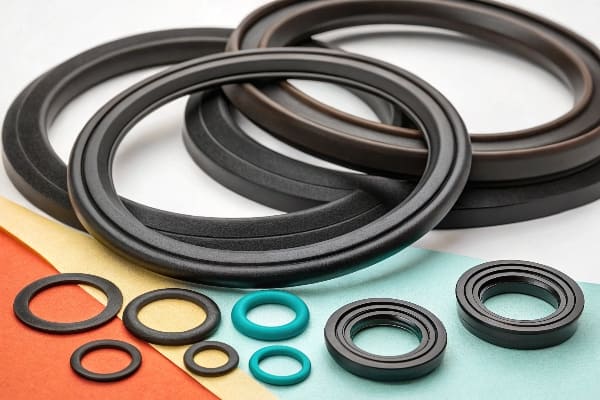Butyl rubber is a type of synthetic rubber that is distinct from other general types of rubber, like natural rubber or synthetic elastomers such as nitrile and silicone. While both butyl rubber and general rubber (like natural rubber) share some common properties, there are key differences in terms of composition, characteristics, and applications.
What is Butyl Rubber?
Butyl rubber, scientifically known as isobutene-isoprene copolymer1, is a synthetic rubber made from a mixture of isobutene and isoprene. This particular blend gives butyl rubber its unique properties, such as exceptional impermeability to gases and low air permeability, which is a significant factor in many of its applications.
Butyl rubber is primarily used in situations where airtightness and resistance to environmental factors such as weather and ozone are crucial. It has superior gas-barrier properties, making it ideal for tire inner linings and other applications requiring airtight seals.
What are the Key Differences Between Butyl Rubber and General Rubber?
Composition and Structure
- Butyl Rubber: Made from isobutene and isoprene, its molecular structure is a copolymer of these two components. This gives it low permeability to gases2, high resistance to ozone, and excellent weathering properties.
- General Rubber: This term generally refers to any rubber material, whether natural or synthetic. For example:
- Natural Rubber (NR): Made from latex, the milky fluid produced by rubber trees, mainly consisting of polyisoprene.
- Synthetic Rubbers (like SBR, EPDM, and Nitrile): These are created by polymerizing various monomers, such as styrene-butadiene for SBR or ethylene-propylene for EPDM.
Properties
-
Butyl Rubber: Known for its low permeability to gases, high resistance to aging, ozone, and weather, making it ideal for sealing applications and inner tubes of tires. It also has good insulation properties and is often used in chemical-resistant applications.
-
General Rubber: Properties vary based on the type of rubber. For instance:
- Natural Rubber (NR): Known for its high elasticity and excellent tensile strength, making it ideal for applications needing high stretch and resilience.
- SBR: Known for its good abrasion resistance and vulcanization properties, widely used in tire manufacturing and automotive parts.
- Nitrile Rubber (NBR): Offers excellent resistance to oils and fuels and is often used in gaskets and seals.
Resistance
-
Butyl Rubber: It stands out for its superior resistance to oxygen, ozone3, and UV degradation. This makes it highly suitable for products exposed to outdoor weather conditions.
-
General Rubber: Resistance varies depending on the type of rubber. For example:
- SBR is less resistant to ozone and oxidation compared to butyl rubber, and NR can degrade faster when exposed to UV light and ozone.
- Nitrile rubber has excellent resistance to oils and hydrocarbons but is not as resistant to ozone as butyl rubber.
Applications
-
Butyl Rubber: Due to its gas-impermeability, butyl rubber is commonly used in:
- Tire inner tubes
- Medical and pharmaceutical products
- Seals and gaskets for the automotive and chemical industries
- Soundproofing materials, like for automotive applications
- Aerospace components due to its resistance to harsh environmental factors
-
General Rubber: Applications depend on the type of rubber:
- NR is widely used in footwear, hoses, and rubber bands.
- SBR is most commonly found in automotive tires, conveyor belts, and gaskets.
- Nitrile Rubber is primarily used for fuel and oil-resistant seals, gaskets, and O-rings.
Cost and Availability
-
Butyl Rubber: Generally more expensive than natural rubber or some other synthetic rubbers due to the complex manufacturing process. However, its specialized properties justify the cost for certain applications.
-
General Rubber: The cost can vary. Natural rubber is often cheaper than most synthetic rubbers like butyl, EPDM, or Nitrile, although synthetic rubbers can offer more tailored properties for specific applications.
Summary Table of Key Differences
| Property | Butyl Rubber | General Rubber |
|---|---|---|
| Composition | Isobutene and isoprene copolymer | Varies (e.g., polyisoprene for NR) |
| Gas Permeability | Very low | Varies (NR and SBR have higher permeability) |
| Ozone Resistance | Excellent | Varies (NR is more susceptible) |
| Weathering Resistance | Excellent | Varies (SBR and NR degrade faster) |
| Tensile Strength | Moderate | Varies (NR has high tensile strength) |
| Cost | Relatively high | Generally lower (NR, SBR) |
| Main Applications | Tires, seals, chemical-resistant products | Tires (SBR), gaskets (NBR), footwear (NR) |
Conclusion
Butyl rubber offers unique properties such as low gas permeability and excellent resistance to ozone and aging, making it a superior choice for applications where airtightness and environmental durability are crucial. On the other hand, general rubber types like natural rubber (NR) or synthetic rubbers such as SBR offer different advantages in terms of elasticity, tensile strength, and cost-effectiveness. The choice between butyl and general rubber largely depends on the specific requirements of the application. Understanding the strengths and weaknesses of each type of rubber is essential for selecting the right material for the job.
Footnotes:
-
Explore this link to understand the unique properties and applications of isobutene-isoprene copolymer, crucial for various industries. ↩
-
Learn about the significance of low gas permeability in rubber materials, especially in tire manufacturing and sealing applications. ↩
-
Discover how superior resistance to oxygen and ozone enhances the durability and lifespan of rubber products in various environments. ↩









